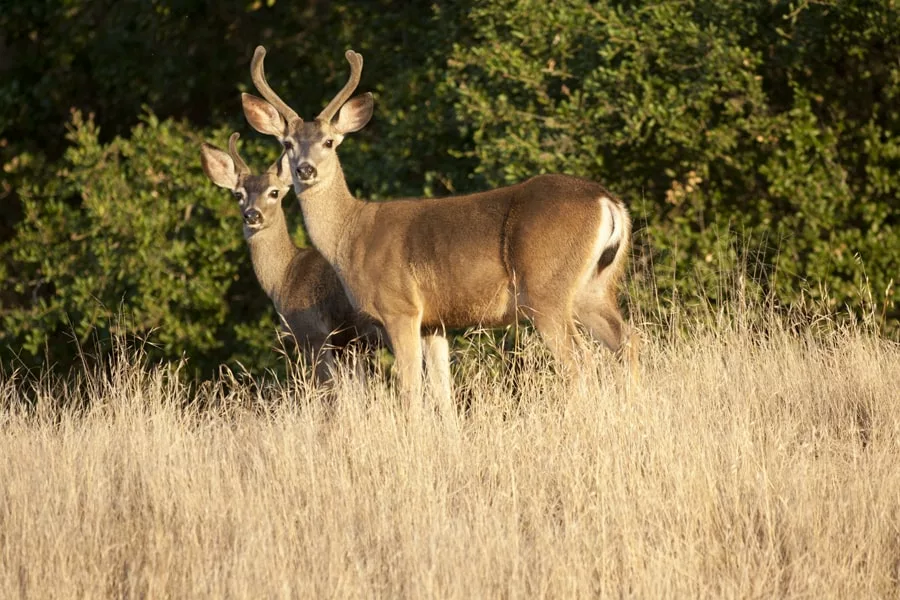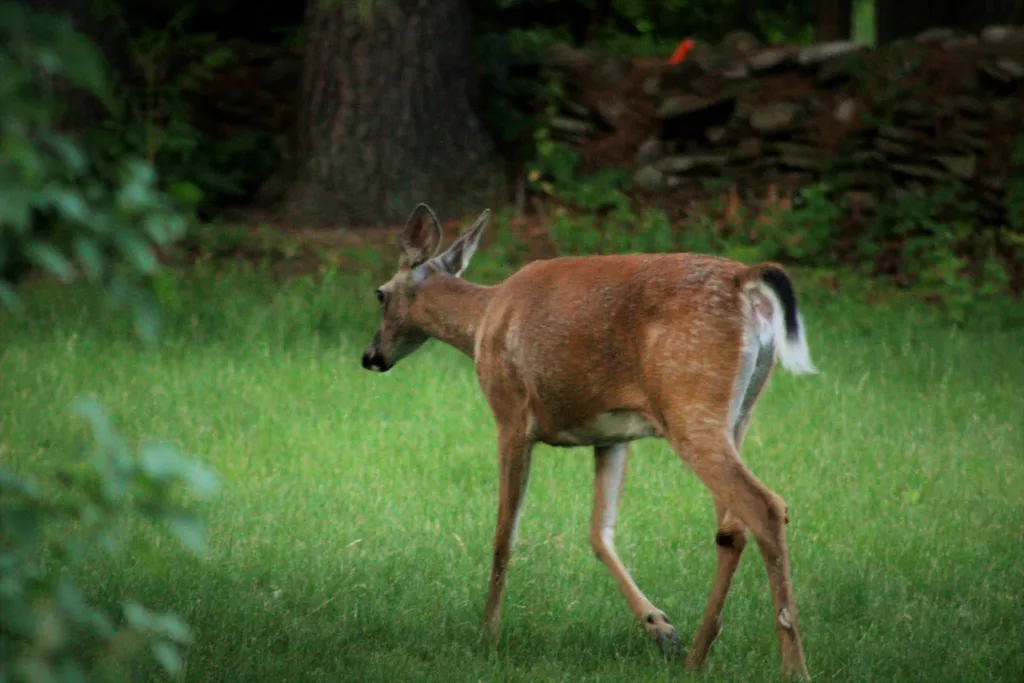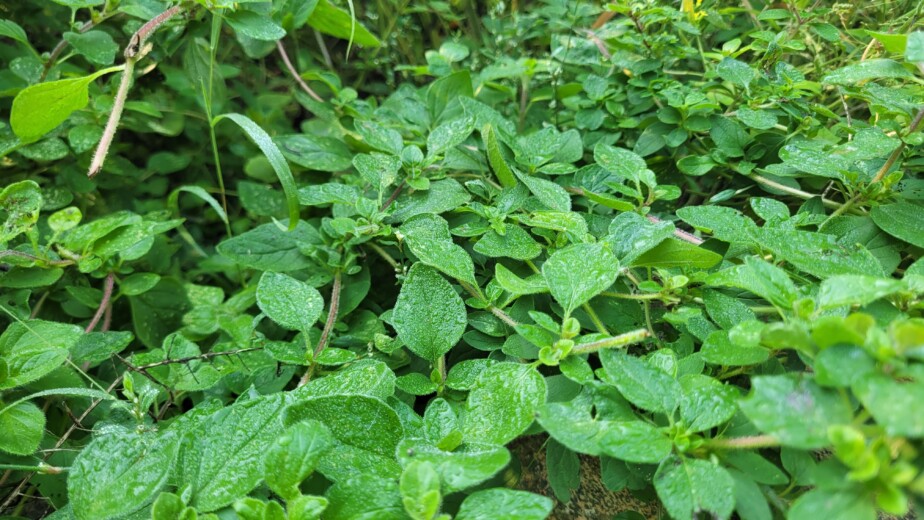This post may contain affiliate links. If you use these links to buy something we may earn a commission. Thanks.
Several smells repel deer from an area and the best option is all of them, maybe not all at once, but a different recipe once in a while will keep your area uncomfortable for deer and pleasant for you.
You’ll learn how to make and use effective bad-smelling and good smelling (to you) recipes that repel deer from any area.
Strong smells, in general, keep deer away because it hinders their ability to detect danger with their nose. In combination with a wide variety of ‘non-tasty’ plants, deer will have no reason to stay or even bother coming in to investigate the rather ‘useless’ food selection in your ‘unsafe’ area.
Each recipe can be made with a blender and applied to plants or objects with an easy sprayer or a pre-filled-with-bobbex sprayer.
None of these recipes will do harm to your plants, but rather protect them from hungry deer.
Order deer-resistant shrubs, herbaceous perennials, bulbs, roses, and ground covers all in one place.
While strong scents and unpleasant tastes are effective ways to deter deer from an area, they may not be enough by themselves for persistent or famished deer.
Combining motion tactics with confusing smells will increase the uncertainty of your yard since lurking predators are their #1 worry.
See: How To Creation Motion with Household Items to Repel Deer

What smells repel deer
Not just any smell will repel deer, as landscapes are filled with all sorts of smells that we don’t so easily differentiate.
Foul sulfur and strong herbs applied to desirable plants will repel deer from eating them. Deer have a heightened sense of smell compared to us and if these aromas encompass an area, deer will also be repelled from the site in general.
Fresh-cut grass, falls leaves, leaf mold, wood, mushrooms, evergreens, flowers, and more are examples of the wide variety of smells that deer sense every day.
They even smell your ‘deer-resistant’ herbs! So the purpose of making repulsive concoctions, spicy sprays, or fragrant herbal mists—even if they already smell the fragrant plants— is to increase the scent in the area to the point it’s difficult to smell much else.
Or, if they decide to go ahead and nibble anyway, they’ll taste cayenne or the bitterness they dislike in yarrow and officially move on from the ‘weird’ area.
What is the most effective deer repellent?
Deer repellents in general are more or less effective in what they are, what they do, and how long they are implemented.
Strongly scented plants or repulsive concoctions are the most effective deer-repellent smells. Deer stay away from areas that confuse their noses as detecting danger is difficult. Planting a large variety of scent-confusing plants and home-making a variety of repellents can keep deer away for good.
Variety is key.
Below, you’ll find many options to change up the scents in your yard!
The time of day you apply deer repellents, however, is the only constant that you’re best off not changing.
Before dusk is the best time of day to apply any deer repellent as deer tend to feed when the sun is going down, and into the dark. A fresh advantage is a more effective one.
Related: Schedule to Keep Deer Out of The Garden Without A Fence

Natural deer-repellent plants
Before we get into the deer-repellent recipe sprays, you can (and should) naturally incorporate deer-repelling plants.
By planting lots of deer-resistant plants you’ll have added natural protection, and a growing supply of ingredients to make your deer repellents at home.
Not only are these fragrant and deer-resistant plants good for a deer-free yard, but many of these scent confusers deter other garden or tree pests and attract beneficial predators.
Planting fragrant plants is a triple bonus for you and your garden.
The best natural deer-repellent plants are:
- Lavender
- Rosemary
- Thyme
- Sage
- Oregano
- Bee balm
- Mint, catmint, or other
- Chives
- Marigolds
- Yarrow
A strong deer-repellent spray can be made of any of these herbs.
According to our garden and many others, this list of fragrant herbs is rarely eaten by deer. Consequently, they are protective companions to other plants in a garden.
Lavender, rosemary, thyme, oregano, and sage protect deer-loving plants from being found and eaten. The strong scent overpowers an area, masking the smell of nearby plants that deer would otherwise find easily and eat.
These slower-growing deer-resistant options, however, can be expensive to purchase and take a long time to establish and become abundant enough for a working effect. Their slower-growing nature means they tend to live a longer life.
To protect your garden from deer with companion planting, you’ll need a mix of slow-growing and fast-growing herbs.
Bee balm, mint, marigolds, chives, and yarrow are fast-growing deer-resistant plants and very easy to cultivate. They offer a variety of deer-deterring smells and prevent the rest of your garden from detection and damage.
These fast-growing herbs have a shorter lifespan. Mint, marigolds, bee balm, and yarrow re-seed very easily and almost invasively, which is easily controlled (by cutting and collecting the seed heads).
Yarrow is also spread by underground stems, and mint spreads using above-ground stems.
Fast-growing plants are either labeled “invasive” to a garden or abundantly useful to the gardener. So, if you plan to make deer repellents or personal cups of tea, these are great plants to have. Personally, we do both and love how quickly and abundantly they keep up with our demands.

This article was originally published on foodforestliving.com. If it is now published on any other site, it was done without permission from the copyright owner.
For those determined to have a deer-free landscape Deerproofing Your Yard and Garden by Rhonda Massingham Hart is well worth the read.
When I was searching online to plant ‘deer resistant’ plants, I ran into several contradictions. Contradictions could come from
The University of Vermont pointed out a helpful list of controversial plants that some have claimed deer dislike while others have claimed they like.
The list of controversial plants includes (but is not limited to):
- clematis
- iris
- forsythia
- dahlias
- vinca
- trillium
- peonies
I’ve even seen people say daylilies are deer resistant, but they definitely love daylilies, as we do.
I have not noticed deer eat our irises or trilliums, but that doesn’t mean they won’t, or haven’t. For us, it means they have plenty of other preferred options—because they do!
On to the recipes!
Each of these below deer-repelling ingredients can be made as a recipe on its own, or, you can combine all or several ingredients into a single ‘ultimate’ deer-deterring concoction.
Putrefied egg solids
I recently found out from The Connecticut Agricultural Experiment Station that putrid eggs don’t necessarily deter deer because it only smells horrible.
Predators mark their territory with their urine, and eggs share a similar sulfurous smell. For this reason, raw eggs that have become putrescent are agreed to be effective at repelling deer due to territory perception.
Putrescent egg solids mimic the smell of predatory urine and keep deer away out of fear of being ambushed. The strong smell of this mixture also works by masking the faint smells of plants that deer love to eat, making your garden harder to find.
First, deer are likely to keep their distance, to begin with, when detecting the smell of sulfur hundreds of feet away.
Second, if a deer decides to come in closer to investigate, it’ll take longer to find the plants they desire to eat because the strong scent masks more faint smells.
Third, as it requires deer more time to find food in your garden due to the scent confusion, they will feel more skittish while in your area as they may fear ambush and be on higher alert.
Therefore, if you combine one or two other deer scare tactics that stimulate their other senses, you’ll have an affordable garden defense strategy as effective as the best tall deer fence.
See: 11 Easy Noises & Sounds To Scare Deer Away For Good
To make strong putrescent eggs as a deer repellent:
- Blend or whisk 2 eggs with 2 cups of water
- Strain the mixture through a fine sieve
- Transfer the concoction to an old milk jug
- With the lid secured, place it in a sunny spot outdoors for at least 3 days
- When ready to use, add 12 cups of water
Once transferred to your spray bottle, spray vulnerable plants but avoid coating the fruits and vegetables you plan to eat in rotten-egg spray.
Save the following recipes for coating the plants you eat (if necessary).
Homemade deer-repellent essential oils recipe
Essential oils such as rosemary, mint, cinnamon, clove, lavender, sage, oregano, and more exaggerate the strong scent of deer-resistant plants, as they are too strong for their nose and pallet.
The intensity of sprayed homemade essential oil deer repellent can mask plants that deer would otherwise desire to eat.
The recipe for preparing an essential oil spray is simple. Add 2-2.5 teaspoons of choice essential oil to 14 cups of water. Essential oils make homemade deer repellent easy and convenient to make.
While this sounds expensive, you’d be better off rotating the use of scent-based repellents and using essential oils once per month—so you’ll only need to use 6-12 teaspoons of any essential oil over the course of the growing season.
Plus, you don’t have to use a tiny bottle of essential oil. Plenty of large bottles provide easy access to full droppers of essential oil.
Alternatively, if you’re growing your own deer-resistant herbs and wish to use them to brew your concoctions you could make a sun-brewed infusion.
- Use 1 part fresh ‘plant’ such as rosemary, mint, etc
- with 2 parts of choice oil such as sunflower or olive
- Either slow cook for 6 hours or set on a sunny windowsill for up to a week
- Strain with a fine mesh sieve
- Dilute with water (1 tablespoon to 12 cups water) before adding to your sprayer and applying to plants
- Store the infusion in a dark place and use it up within a year
This one recipe makes ten or more different sprays as it can be followed using all of the essential oils for lavender, rosemary, thyme, sage, oregano, bee balm, mint, chives, marigolds, and yarrow (and more).
Will vinegar repel deer?
With several effective scent-based deer repellents, I wondered if something as simple (and cheap) as vinegar would do the job and what type would be best.
Vinegar offers a punch to the nose, and if we feel it, deer feel it a lot more.
White vinegar is best at deterring deer due to its strong pungent scent. The acidity of the vinegar, however, can be harmful to plants that dislike acidity. An easy way around this, which may be easier than spraying select plants, is hanging vinegar-soaked cloths on stakes.
The benefit of spraying your vinegar deer repellent can help de-clog your sprayer after using the putrescent egg recipe, plus it’s very simple to “make.”
The best vinegar deer repellent recipe is simply:
- pure white vinegar in a bottle, or
- pure white vinegar-soaked cloths
White vinegar is a temporary deer deterrent and a productive, non-wasteful way of cleaning your spray equipment at the same time.
I only use vinegar as a one-time deer repellent between other scent-based methods. This short-term way of use is what makes it especially effective because deer may ‘deal with it’ over time and indulge anyway.
Garlic deer repellent
According to the United Nations Food and Agriculture Organization trials, garlic isn’t the most worthwhile deer deterrent as its repellent effects, when applied to desirable tree seedlings, don’t last greater than 48 hours.
Garlic should be an added ingredient to a more effective, more sulfurous-smelling homemade deer deterrent such as putrescent egg solids.
For this recipe, crush garlic, and add it to the concoction to brew. Strain the garlic solids out before pouring into a spray bottle. Follow the putrescent egg solids steps with the addition of as much garlic as you like.
Growing garlic, even with deer, is very easy as they dislike the plant.
Planted garlic will provide a longer-lasting scent (until bulbs are harvested) than a topical application of garlic ‘spray.’
Cayenne pepper deer repellent
Cayenne peppers and all other spicy peppers repel deer as the capsaicin they contain is very spicy to their extra sensitive noses and spice-virgin tongues.
Cayenne powder with water is too easily washed off of leaves so a simple concoction isn’t an effective one.
The best cayenne pepper deer repellent is made by combining 2 tbsp of cayenne powder (or 2-6 whole cayenne peppers), with 2 raw eggs, and a handful of freshly crushed yarrow in 2 cups of water. Let rest in the sun for 4 days, dilute with 12 cups of water, stir, strain, stir, and use.
How does this work?
- Egg helps bind the items for a fluid consistency and provides a primary defense as deer prefer to keep away from this smell.
- The smell of both cayenne and yarrow acts as a secondary deterrent against nibbling as it’s peppery and bitter.
- If the deer decide to nibble anyway, yarrow and cayenne flavor and alkaloid compounds act as a certain tertiary lesson—reinforcing a ‘wrong’ choice, and inhibiting further damage.
Yarrow and cayenne are the ultimate bitter and spicy taste that a deer won’t want to try ever again.
How often do homemade deer repellents need to be applied?
Any homemade deer repellent is different from commercial products in the length of time they work and how often they need to be applied.
Homemade deer repellents work for 1 to 2 weeks and gradually lose their effectiveness from humidity, rain, and morning dew. Apply homemade deer repellents every 1-2 weeks and after heavy rains to maintain deer-deterring effects. After each application, let dry without water for no less than 2 hours.
If you notice the effectiveness wearing off on your local deer, you’ll need to switch up the types of deterrents you use, make stronger batches, or apply the repellent more often.
If you’re cycling between different modes of deer-deterring tactics using noises, motions, and lights, then you’ll need to re-apply homemade deer repellents less often. Application every 2-6 weeks will be effective, for oil and egg-based homemade deer repellents, when using other tactics to deter deer in between.
What time of day should you spray deer repellent?
Deer tend to forage for food during dawn and dusk. Your homemade deer repellents are most potent when applied fresh.
Early evening is the most convenient time of day to apply a fresh coat of deer repellent for a strong effect to prevent deer from eating your garden during their feeding times.
As you apply each recipe, you can also feed your plants with compost tea if you have a brew on hand. A two-in-one purpose for spraying your plants makes deer deterrent efforts a little less of a chore.
- Add your compost tea to your spray bottle fresh before spraying and foliar feed your plants with nutrients and deer protection.
Various weather conditions, such as heat, humidity, dew, rain, and temperatures, can impact the effectiveness of any scent-based spray repellent.
To be positive your plants are safe, combine any of these scented sprays with noise, motion, or both, but avoid sprinklers as it’ll wash away your hard work!
Up next: Will Deer Chew Through Plastic fencing? How To Avoid Damage
Recent Posts
There’s no shortage of full-sun ground covers for zone 4 climates! Each plant in this list can withstand the frigid temperatures and also enjoy the hot sun in summer. Full sun means that a plant...
There's no shortage of full sun ground covers, not even in zone 3! Zone 3 climates offer hot but short-lived summers and very cold winters. So each plant in this list can withstand the frigid...
